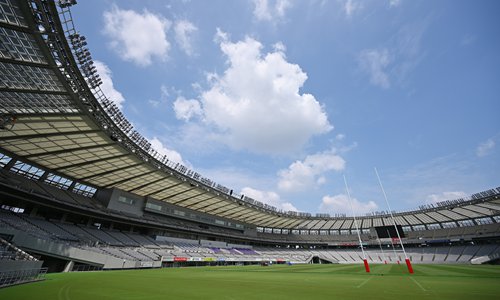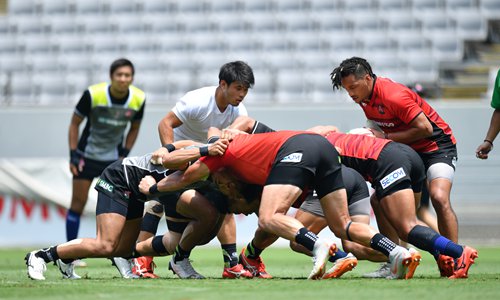HOME >> SPORTS
World Cup hosts Japan face unloved rugby scene
Source:AFP Published: 2019/8/29 20:58:41

A general view of the Ajinomoto Stadium in Tokyo, one of the stadiums for the 2019 Rugby World Cup Photo: IC
Rich clubs owned by massive corporations have attracted a parade of star players to Japan, but the unusual setup hasn't been a hit with fans, prompting a re-think as the World Cup looms.Sparse crowds for Japan's Top League, where giants of the game play alongside amateurs for the pride of major companies, have triggered moves towards a fully professional league as Japan gears up to host Asia's first World Cup.
Dan Carter, Sonny Bill Williams, George Gregan are just some of the luminaries who have plied their trade in Japan, picking up generous pay cheques.
The trend shows no sign of stopping, with All Black captain Kieran Read, fellow New Zealander Brodie Retallick and Australian scrum-half Will Genia among a number of players heading to Japan after the World Cup.
Wallaby fly-half Christian Lealiifano abandoned the captaincy of the ACT Brumbies after receiving an offer he said was "too hard to turn down" from Ichikawa-based NTT Communications.
The Japanese league attracts such top talent - often players approaching the twilight of their careers - because the seasons are short and less physically demanding.
The higher salaries help too. All Black legend Carter was said to be earning around $1.3m at the Kobelco Steelers, not counting the lucrative endorsement deals that saw the World Cup-winning flyhalf become a Japanese media star.
But the high-profile players have failed to bring fans through the turnstiles, with attendances in free-fall and embarrassingly low gates at some matches.
Even the Top League final, which saw the Kobelco Steelers beat the Kubota Spears 43-7 on August 10, attracted a meager crowd of 7,890.
Throughout the season crowds averaged around 2,500, hitting a low of 528 for a match between Toyota Loom and NEC Green Rockets.
Crowds are small because there is no loyalty for the corporate-based teams, said Akimoto Hinato, an expert in rugby in Japan.
"The championship is made up of corporate clubs. They don't represent a town, don't have a stadium and their 'home' games are played from Kyushu to Hokkaido," at opposite ends of the country, said Hinato. "It is difficult under these conditions to pull in a crowd apart from supporters of the company."

Japanese national team players take a training session at the Ajinomoto Stadium on July 29. Photo: IC
'Anyone with two legs'The Top League has a unique structure, with Japan Inc powerhouses like Toyota, Toshiba, Mitsubishi and Honda prepared to splash serious cash to run a side for company prestige. The system started after the war when companies such as Kobe Steel founded rugby clubs and encouraged employees to play to improve morale and fitness.
As late as the early 2000s, the league was known as the Japan Company Rugby Football Championship, only changing to the Top League in 2003 in a bid to become more professional.
But even now, many teams are a mix of former internationals on hefty salaries and company employees, who have been known to miss training for meetings.
This hybrid pro-am system was exposed during a recent Japanese national team tour to England when it emerged the amateur players were getting a daily allowance of just 2,000 yen ($19).
Unsurprisingly, it's also had an impact on quality.
Fiji's Nemani Nadolo has been quoted as saying that "anyone with two legs could play there" and Japan's test captain Michael Leitch has raised doubts about the ability of the competition to breed Japan internationals of the future.
But Hinato noted that foreign stars have raised standards among Japanese players, helping Japan become one of the top sides outside the traditional rugby heartlands.
'Bigger than the World Cup'
Japan's rugby hierarchy hoped the creation of a Super Rugby franchise, the Sunwolves, would further boost standards, as Japanese players compete with the best teams in the southern hemisphere.
But after being introduced in 2016 with great fanfare, Super Rugby organisers decided to throw out the Sunwolves, who had often been whipping boys in the competition, after 2020.
In contrast to the Top League sides, the Sunwolves regularly sold out their Tokyo stadium despite the lack of success on the pitch.
Moves are now afoot for a professional league from 2021 featuring clubs representing the 12 cities that are hosting World Cup games, including the Sunwolves playing for Tokyo.
Between six and eight Top League clubs have already signed up for this new vision, said Hinato, with the rest of the league to be restructured into a regional amateur league.
"This is the most important event for the future of Japanese rugby, even bigger than the Rugby World Cup itself," said the expert.
Newspaper headline: Big stars, small crowds
RELATED ARTICLES: